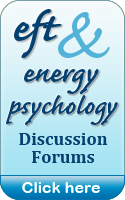Effective EFT
How and Why it works
By
Carolyn Rigiero
(Add or view comments at the bottom of the page.)
When I started using EFT about eight years ago, I thought it was next to miraculous. Over the years, after using it on myself and clients, I’ve come to re-think the miracle. Today, I view it as a practical alternative tool, along with all the other alternative processes I keep in my modalities tool kit, no more or no less miraculous than anything else at my disposal. However, as with other alternative processes, properly used, it is powerfully useful.
Whether using EFT or another modality, when meeting a new client, I find that taking an in-depth history of the client’s complaint starts the healing process. It sets the client up to begin to deal with the issue that brought him to me. Here is where EFT excels. Just as talking about the issue in an historical sense brings the thoughts, feelings, anxiety to the forefront allowing clients to confront them head-on, EFT compounds this in its set-up phrase. Because EFT begins with a negative statement about the client and/or what the client has experienced at the very outset, the attention is placed squarely where it belongs, on the issue itself. What is important here is that the client re-experiences the feelings and thoughts associated with the event, not the event itself (EFT has a way of addressing the actual event, but that explanation is for another time). It is these feelings and thoughts our client needs to dispel in order to move on. This is what I call going from the global to the specific, exactly what we are asked not to do. However, I find that in some instances, especially when dealing with intense emotions, starting globally can release some of the emotions; then we can go to the specific and work on the event itself.
There are many explanations as to why EFT (or other alternative modalities) works so well, some physiological, some psychological, some magical. Saving the physiological and magical for another time, the psychological explanations are valid. Firstly, the client is getting “in touch” with himself (both literally and figuratively) by addressing his issues with an intent to accept them and move on. Here, the intention or desire to address, accept and move on goes a long way towards healing. Without this intention, any work done on this issue is futile. It’s like forcing someone to acquire a skill they have no interest in, then finding they’ve learned nothing. However, when a client comes in with this intention, the changes necessary to his healing have already begun.
Next, when a client works with a practitioner, it means someone is actively listening and paying attention to him: He is being heard. Unfortunately, in the chaos of our everyday world, this happens too seldom. Thus, hearing the client, being present with him and for him increases his sense of self-worth and self-esteem which is so often missing in many of us. Knowing that someone is there, in your corner, is supportive and reassuring that your concerns are being taken seriously.
Further, when working with EFT, (and/or other modalities) the client puts a voice to his thoughts and feelings. By repeating the set-up phrase, and then the reminder phrases, he is continuously exposing himself to his issue and what his feelings are towards it. This is similar to Exposure Therapy, where the client is gradually re-conditioned away from an initial negative response through repetition, desensitizing the client so that the negativity loses its meaning.
Whether one is using EFT on oneself or a client, EFT is an effective tool. It is not a magic tool, but it is an effective one, whose first line of defensive is, I believe, psychological. Much has been touted about its relationship to Einstein, as well as what happens physiologically in the brain during its use. However, I am still waiting to read a convincing treatise on how E=Mc2 (Einstein’s mass-energy equivalence theory, which in its purist form is meant to understand and control nuclear reactions) is related to what happens when using EFT. Until then, I take EFT at its face value: An effective tool to help my clients heal.
View All Articles by this Author
Author's Bio:
Carolyn Rigiero, CCHt, received her EFT-ADV certificate in 2007. Since then she has been teaching EFT both beginning and advanced classes, at HCH in Lafayette, CA. She also uses EFT in her practice, often coupling it with a hypnotic journey. To reach Carolyn, please call 925-408-8644 or email her at tap_it_down@yahoo.com
Leave a Comment
Disclaimer: All information on this website is for educational purposes only, and the content is not intended to suggest that it is a
substitute for proper medical care or good common sense.
While EFT has produced remarkable clinical results, it must still be considered to be in the experimental stage
and thus practitioners and the public must take complete responsibility for their use of it.
In addition, the articles on this site represent the views of the authors and do not necessarily reflect those of the
founder of EFT, Gary Craig, nor the owner of this web site, Stefan Gonick.
|





 EFT never ceases to amaze me! The process is gentle and often provides benefits where other methods fail.
EFT never ceases to amaze me! The process is gentle and often provides benefits where other methods fail.

